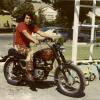-
Recently Browsing
- No registered users viewing this page.
-
Topics
-
Posts
-
By nevenbekriev · Posted
The problem is that this movements were not produced with the modern level of standartization, there for parts from one didn't fit well to another, even if they may look the same. May be it doesn't concern the winding stems, but yet there are not spare parts for such movements in supply companies, not even clear calibre identification possible. And where calibre identification is possible, there are no Ronda numbers for the balance staff or the winding stem for this calibers in the data bases. -
That black stuff - I had similar things happen with evaporust! In that case I understand the evaporust eats the iron oxide away without hurting the metal but it can leave behind a layer of carbon which was in the steel that got oxidised. I spent ages trying to perfect a cleaning regime with various different stages in jars in an ultrasonic bath. In the end I switched to washing all but the balance and pallet fork in IPA and gently brushing it with a small artists brush. I would estimate that I have found an extra 20º of amplitude doing this! It also takes me no longer than waiting hanging over a tank to move stuff to the next jar If it is really bad then I have used the IPA as a prewash and go through my old routine
-
I thought is FHF. Sounds good to make winding stem by myself but I am not in watchmaking on this level. 😄
-
At a friend's request, I've obtained a key for her long case clock which has been silent for some years. On winding it, the weight only rises a foot or so from the floor - & is not visible above the lower panelled section - before the key meets significant resistance. However it then runs quite happily for a day or so by which time the weight is again on the floor. I haven't had the chance to examine the movement but would be grateful for suggestions as to what might be happening here.
-








Recommended Posts